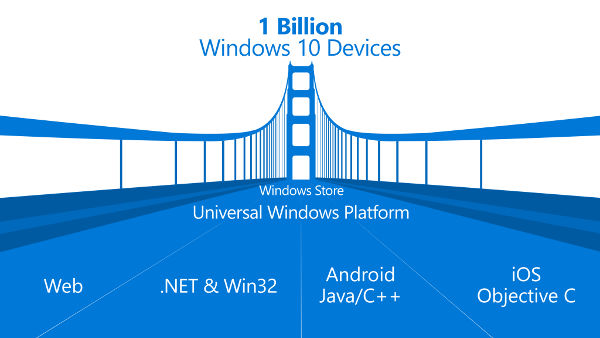| Microsoft's Islandwood Now On GitHub - An iOS Bridge To Nowhere? |
| Written by Mike James | |||
| Friday, 07 August 2015 | |||
|
The problem with a bridge is that no matter how beautiful or structurally ingenious it is, if there are no takers for the crossing then it is a bridge to nowhere. Microsoft has delivered a first look at Islandwood, its "bridge" that takes iOS programs to Windows Universal. Are there any compelling reasons for iOS apps to take the trip? One important part of Microsoft's attempt to break that circle of app poverty on Windows Mobile are the "bridges" it is attempting to build to more app rich platforms. We already have Westminster, which is a handy way to create a web app that runs on Windows 10, but not likely to attract huge numbers of developers to create killer apps. Now Microsoft has announced an early look at "Islandwood" as its iOS to Windows 10 bridge is codenamed. Could this be a source of killer apps?
The first surprise is that it is open source. This makes sense as Microsoft doesn't actually want to make money from the bridge. The idea is to get more apps for Windows 10. Hence open sourcing it is good sense as whatever users it gets can help with making it work. It is worth noting, however, that not all of the system is being open sourced. The bridge consists of four components:
The iOS apps are not 100% complete after compiling. The announcement says: "Empower developers to reuse as much existing iOS code as reasonably possible" In addition iOS apps will have access to all of the Windows API and will be treated equally with true Universal Windows apps. Currently the project supports Windows 8.1 and Windows 10 apps, but not ARM. This will come later and allow full support for Windows Mobile, i.e. phones. So the bottom line is that the really important part of the project, the compiler, isn't open source and the amount of work needed to make an existing iOS app work convincingly on Windows certainly isn't zero. There is also news on the other bridges. Project Astoria, the Android bridge, is currently in invitation-only preview with the promise of a public beta in the fall. One interesting piece of information is that Microsoft is helping out on Google's open source project ANGLE. This is an OpenGL to DirectX translation tool. Obviously Android uses OpenGL for its advanced graphics and something has to be done to make it run with DirextX. I wonder if Google had any idea that its project would help Microsoft get a share of Android applications. Finally the bridge for classic Windows apps, Centennial, will be available sometime next year. If anyone wants to convert .NET and Win32 apps to Windows Store apps only time will tell. Indeed the big question is what is the size of the queue forming up to cross all these bridges? At the moment Microsoft seems to be emphasising the route to Windows 10 desktop, laptop and tablet. This could be because the code for phones is lagging. The problem that all these bridges are being built for also seems to make it less enticing to cross any of them. At the moment there is still a very small market for Windows Phone apps and why bother converting a high earning iOS app, with all the undoubted pain, for such a small market? Could it be that Microsoft is trying to make the entire Windows 10 installed user base look like the real market? If so this is a clever move, but it raises some questions as well. Presumably the argument is that a Universal Windows App runs on everything so your market isn't just the phone. However most iOS and Android apps are phone apps - and who wants a phone app running on a desktop? In the last analysis, what really matters is how easy it will be to cross these bridges. If the cost is next to nothing then why not just nip across and see what the market is like? If the cost is high, or just perceived to be high, my guess is that there will be only a small number of dedicated bridgers.
More InformationOpen Sourcing the Windows Bridge for iOS Windows Bridge for iOS: Let’s open this up Related ArticlesWindows 10 SDK And Tools - Almost There! Project Westminster - Another Web App Format Why Should We Write Universal Apps When Microsoft Drops Them - Skype To Go Desktop Only Android And iOS Apps For Windows 10 Survey Reveals App Poverty Line
To be informed about new articles on I Programmer, install the I Programmer Toolbar, subscribe to the RSS feed, follow us on, Twitter, Facebook, Google+ or Linkedin, or sign up for our weekly newsletter.
Comments
or email your comment to: comments@i-programmer.info
|
|||
| Last Updated ( Friday, 07 August 2015 ) |



